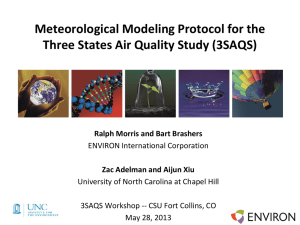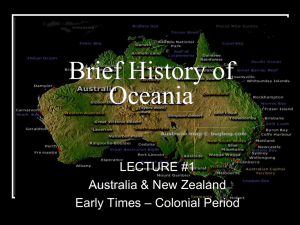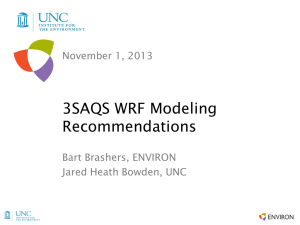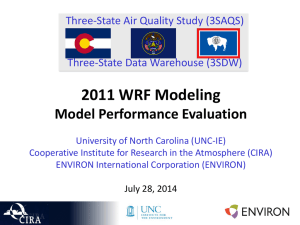Professor Tom Lyons, Centre of Excellence for Climate
advertisement
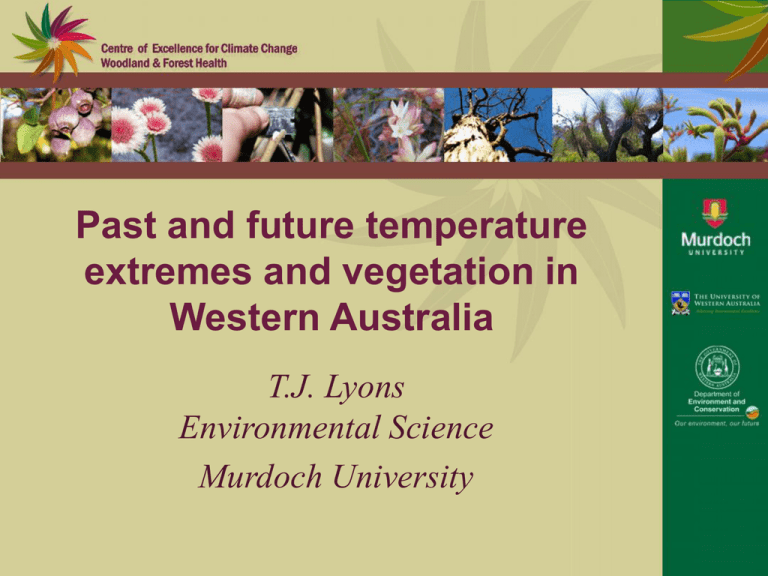
Past and future temperature extremes and vegetation in Western Australia T.J. Lyons Environmental Science Murdoch University Evans, B.J and T.J. Lyons, 2013: Bioclimatic extremes drive forest mortality in southwest, Western Australia Climate, 1, 28-52; doi:10.3390/cli1020028 Evans, B.J and T.J. Lyons, 2013: Bioclimatic extremes drive forest mortality in southwest, Western Australia Climate, 1, 28-52; doi:10.3390/cli1020028 Evans, B.J and T.J. Lyons, 2013: Bioclimatic extremes drive forest mortality in southwest, Western Australia Climate, 1, 28-52; doi:10.3390/cli1020028 Maximum temperature - February Maximum temperature – February 2050 Minimum temperature - February Minimum temperature – February 2050 Times series of Australian areally averages Alexander, L.V. and J.M. Arblaster, 2009: Assessing trends in observed and modelled climate extremes over Australia in relation to future projections Int. J. Climatol., 29, 417-435. Lyons, T.J., 2002: Clouds prefer native vegetation. Meteorology and Atmospheric Physics, 80, 131-140. CORDEX AustralAsia Domain Dynamic downscaling Soils Synoptic forcing Land use Topography Mesoscale meteorological model Sea surface temperatures Climate 20C ERA-INT CCSM CSIRO ECHAM5 MIROC IPCC AR4 Projected Climate CMIP3 CCSM-A2 MIROC-A2 ECHAM5-A2 CSIRO-A2 IPCC AR5 Projected Climate CMIP5 CSIRO CCSM4 ECHAM6 MIROC ACCESS All simulations are 362 sequential months to preserve variables such as soil moisture and require approximately 8 hours per simulated month on 12 nodes (144 CPUs) with 23GB memory per node, producing 42948 GB of storage per 30 year simulation Regional climate models are sensitive to the forcing data used, as well as different model physics options – validation of model set up against 2010 observations Kala, J., J. Andrys, T.J. Lyons, I.J. Foster and B.J. Evans, 2014: Sensitivity of WRF to driving data and physics options on a seasonal timescale for the southwest of Western Australia. Climate Dynamics (revised) 2010 Observations Kala, J., J. Andrys, T.J. Lyons, I.J. Foster and B.J. Evans, 2014: Sensitivity of WRF to driving data and physics options on a seasonal timescale for the southwest of Western Australia. Climate Dynamics (revised) WRF realisation of 2010 at different grid resolutions Kala, J., J. Andrys, T.J. Lyons, I.J. Foster and B.J. Evans, 2014: Sensitivity of WRF to driving data and physics options on a seasonal timescale for the southwest of Western Australia. Climate Dynamics (revised) Validation of 30 year climate simulation against gridded Bureau of Meteorology observations 5 km x 5 km grid point comparison 30 year climatology Minimum temperature Perkins Skill Score measures the agreement between probability density functions at each grid point Andrys, J., T. Lyons and J. Kala, 2014: Validation of WRF downscaling capabilities over Western Australia to detect rainfall and temperature extremes. American Meteorological Society Annual meeting, Atlanta. Maximum temperature Andrys, J., T. Lyons and J. Kala, 2014: Validation of WRF downscaling capabilities over Western Australia to detect rainfall and temperature extremes. American Meteorological Society Annual meeting, Atlanta. Precipitation Andrys, J., T. Lyons and J. Kala, 2014: Validation of WRF downscaling capabilities over Western Australia to detect rainfall and temperature extremes. American Meteorological Society Annual meeting, Atlanta. Absolute Seasonal PPT Bias (mm/month) D02 10 km DJF MAM JJA SON D03 5 km Andrys, J., T. Lyons and J. Kala, 2014: Validation of WRF downscaling capabilities over Western Australia to detect rainfall and temperature extremes. American Meteorological Society Annual meeting, Atlanta. Tropical Nights (TR) Annual count of nights where TMIN > 20°C - simulation is significantly overestimating the southerly extent of the TR index Andrys, J., T. Lyons and J. Kala, 2014: Validation of WRF downscaling capabilities over Western Australia to detect rainfall and temperature extremes. American meteorological Society Annual meeting, Atlanta. Frost Days (FD) Annual count of nights where TMIN < 2°C. Spatial distribution of frost susceptible areas is well simulated but modeled number of FD is generally higher than observed, especially in the western Wheatbelt. Andrys, J., T. Lyons and J. Kala, 2014: Validation of WRF downscaling capabilities over Western Australia to detect rainfall and temperature extremes. American meteorological Society Annual meeting, Atlanta. Summer Days (SU) Annual count of days where TMAX > 34°C. Spatial distribution and overall count of SU is very well simulated. Andrys, J., T. Lyons and J. Kala, 2014: Validation of WRF downscaling capabilities over Western Australia to detect rainfall and temperature extremes. American Meteorological Society Annual meeting, Atlanta. Max 1 Day Rainfall Intensity (RX1d) Relative (%) bias (wrf-obs) for RX1d for domains D02 and D03. With the exception of the eastern perimeter, RX1d is well simulated. D03 reduces the negative bias in the north west corner however bias sees a small increase throughout the domain at this higher resolution. Andrys, J., T. Lyons and J. Kala, 2014: Validation of WRF downscaling capabilities over Western Australia to detect rainfall and temperature extremes. American Meteorological Society Annual meeting, Atlanta. Longest Run of Consecutive Dry Days (CDD) Tends to underestimate dry days in the south of the domain. Strong positive bias introduced into northern grid in D03 which suggests that this higher resolution domain is not capturing all of the rainfall events. D02 shows the stronger simulation performance. Percent Andrys, J., T. Lyons and J. Kala, 2014: Validation of WRF downscaling capabilities over Western Australia to detect rainfall and temperature extremes. American Meteorological Society Annual meeting, Atlanta. SPII: Simple Precipitation Intensity Index mm/rain day Andrys, J., T. Lyons and J. Kala, 2014: Validation of WRF downscaling capabilities over Western Australia to detect rainfall and temperature extremes. American Meteorological Society Annual meeting, Atlanta. RX5d: Maximum 5 Day Rainfall Intensity Underestimating the highest intensity rainfall periods and hence the contribution of these periods to overall rainfall mm Andrys, J., T. Lyons and J. Kala, 2014: Validation of WRF downscaling capabilities over Western Australia to detect rainfall and temperature extremes. American meteorological Society Annual meeting, Atlanta. PRCPTOT: Annual Number of Wet Days Andrys, J., T. Lyons and J. Kala, 2014: Validation of WRF downscaling capabilities over Western Australia to detect rainfall and temperature extremes. American meteorological Society Annual meeting, Atlanta. R95pTOT: Annual rainfall when intensity exceeds the 95th percentile Andrys, J., T. Lyons and J. Kala, 2014: Validation of WRF downscaling capabilities over Western Australia to detect rainfall and temperature extremes. American Meteorological Society Annual meeting, Atlanta. Summary of Findings WRF is able to capture the spatial structure of precipitation extreme metrics at the 5km resolution Simulation tends to underestimate the magnitude and therefore contribution of high intensity rainfall in the coastal regions. Statistical distribution of diurnal events simulated with skill however minimum temperatures are slightly skewed to the right (generally warmer than observed) and maximum temps are skewed left (generally colder than observed). Colder extremes (Frost Days) of temperature were modeled with skill as were hot extremes (Summer Days). Initial indication of projected changes – CSIRO model Base climate 1979-1999 300C 350C 400C Projected climate 2029-2049 Probability of daily maximum temperatures exceeding threshold Based on generalised extreme value (GEV) distribution 00C 50C Probability of daily minimum temperatures exceeding threshold 100C Heat stress 1989-1999 Cold stress Heat stress 2029-2039 Frost days 1989-1999 Frost days 2029-2039 Changes in variance are significant Under a warming drying climate in the southwest high resolution simulations of downscaled general circulation models highlight an increase in heat and cold stress Current observations illustrate that under these conditions native vegetation is more susceptible to pest attack .
